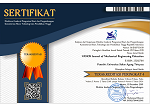INCREASING ACTIVITIES AND RESULTS OF STUDENT LEARNING CHASIS LESSON THROUGH PBL ( PROBLEM BASED LEARNING) LEARNING MODEL IN VOCATIONAL SCHOOL
Abstract
This study aims to: 1) To find out whether or not student activity has been applied to the PBL model ( Problem Based Learning ) on the XI class chassis subjects at PN Purworejo Vocational School. 2) To find out whether or not student learning outcomes increase after the PBL model ( Problem Based Learning ) is applied on the XI class chassis subjects at PN Purworejo Vocational School. This type of research is Classroom Action Research. This research was conducted in two cycles. The subject of this action research is a class XI student of Engineering Program kendaraa n Light The PN Purworejo Vocational School 2018/2019 , which numbered 27 students, consisted of 26 male students and 1 female student. The aspects studied included curiosity, behavior, and activeness of students who showed students' enthusiasm for learning and learning actions shown by the teacher as indicators of implementing learning with problem-based learning models. After the data is obtained then it is analyzed using percentage description techniques. A nalisis data by quantitative descriptive analysis to find the average percentage of the activity and student learning outcomes. The results of this study are that activeness and student learning outcomes increase from each cycle. This can be seen from the increase in the average score of student activity from the pre-cycle with a percentage of 70.37% categorized as less, up to 82.87% in the good category and increasing in the second cycle that is equal to 90.89% and falls into the very good category . While for student learning outcomes can be seen from the increase in learning outcomes by applying the problem based learning model ( Problem Based Learning ). Based on results the average learning of students who meet competency standards is as follows: in the pre cycle the average value is 72.37 with a percentage of 29.63% in the sufficient category then increasing in the first cycle with an average of 81.03 with the percentage is 51.85% and is included in the good and increasing category in the second cycle with an average of 90.66 with a percentage of 88.88% and included in the excellent category.
Keywords
Full Text:
PDFReferences
Amir, M. Taufiq. 2009. Inovasi pendidikan melalui problem based learning. Jakarta: kencana.
Departemen Pendidikan Nasional Republik Indonesia, 2003, "Undang-Undang Republik Indonesia Nomor 20 tahun 2003 Tentang Sistem Pendidikan Nasional", jakarta, Depdiknas.
Hamalik, Oemar. 2014. Kurikulum dan pembelajaran. Jakarta: PT Bumi Aksara
Kurikulum, A. K. T. (2013). Bab 2 kajian teori a. Kajian Tentang Kurikulum 2013, hal. 33–39.
Madya,Suwarsih. (2006). Teori dan Praktek Penelitian Tindakan Kelas (Action Research): Bandung. Alfabeta. Kemmis taggart. (2006). No Title. Model Penelitian Ptk, 22–38.
Nafiah, Y. N. dan, & Suyanto, W. (n.d.). Penerapan model problem-based learning untuk meningkatkan keterampilan berpikir kritis dan the application of the problem-based learning model to improve the students critical thinking, (c), hal. 125–143. jurnal http://www. uny.ac.id.
Setuju, S. (2017). Implementation Of Project Based Learning Model For Improving Students Learning Outcomes Of Advanced Machining Engineering In Universitas Sarjanawiyata Tamansiswa. VANOS Journal of Mechanical Engineering Education, 2(1).
Slameto.2013. Belajar & faktor-faktor yang memperngaruhi. Jakarta:Rineka Cipta.
Sudjana Nana. 2017. Penilaian Hasil Proses Belajar Mengajar. Bandung: PT. Remaja Rosdakarya.
Suyitno, Iis Widiyanto, Suryaneta binti Masrul. 2018. Development Of Learning Media For The Course Of Two-Stroke Gasoline Motors To Improve Students’ Learning Outcomes. Jurnal pendidikan Teknologi Kejuruan (JPTK). Volume 24, No 1. Mei 2018. https://journal.uny.ac.id/index.php/jptk/article/view/18008
Suyitno. 2018. Metodologi Penelitian Tindakan Kelas Eksperimen dan R & D. Alfabeta: Bandung
Suyitno,S., Pardjono, P., & Sofyan, H. 2017. Work Based Learning Terintegrasi Konsep, Strategi dan Implementasi dalam pendidikan Kejuruan. K-Media: Yogyakarta
Suyitno. 2016. Pengembangan Multimedia Interaktif Pengukuran Teknik untuk Meningkatkan Hasil Belajar Siswa SMK. Jurnal jptk.uny Vol 23, No 1 (2016) . http://journal.uny.ac.id/index.php/jptk/article/view/9359.
Suyitno. 2015. Evaluasi pelaksanaan praktik industri SMK di Yogyakarta. Autotech. vol.06/No.02/Juni 2015. http://ejournal.umpwr.ac.id/index.php/autotext/article/view/2318.
Suyitno, Pardjono. 2018. Integrated Work-Based Learning (I-Wbl) Model Development In Light Vehicle Engineering Competency Of Vocational High School. Jurnal Pendidikan Vokasi Volume 8, No 1, February 2018 (01-11). https://journal.uny.ac.id/index.php/jpv/article/view/14360.
Wibowo, N. (2016). Pembelajaran berdasarkan gaya belajar di smk negeri 1 saptosari gunung kidul. No. 2, Vol. 1, jurnal electronik, informatics, and vocational education.
Winataputra, U. S., et al. (2008). Teori belajar dan pembelajaran. Jakarta: Penerbit Universitas Terbuka.
DOI: http://dx.doi.org/10.30870/vanos.v4i1.5891
Refbacks
- There are currently no refbacks.

This work is licensed under a Creative Commons Attribution 4.0 International License.


.png)
.png)
